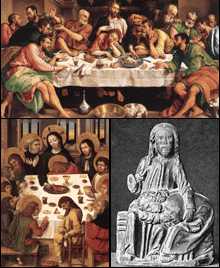
BELOVED APOSTLE: Jesus and John, clockwise from top: Jacopo Bassano’s The Last Supper (1542); Christus-Johannes-Gruppe, 16th-century German stone carving; late-15th-century Dutch painter Meister des Hausbuchs’s The Last Supper.
|
With close to 60 million copies in print worldwide and a film version starring Tom Hanks opening May 18, The Da Vinci Code is a galloping success. That, of course, has whipped up the fury of traditionalist Christians who object to author Dan Brown’s heretical re-imagining of Christian history: that Jesus had a child with Mary Magdalene whose descendents live in France, and that this “proof” of the feminine principle in Christianity has been kept alive by a secret cult that included Leonardo da Vinci, who hinted at it in his art. Da Vinci’s “code,” the story goes, is encrypted in the artist’s rendering of St. John the Evangelist in his famous painting The Last Supper (1498): the androgynous St. John, often called the Beloved Apostle because of Jesus’s special affection for him, is actually Mary Magdalene. Going even further down a feminist path, Brown casts the Mona Lisa (1506) as an epicene vision of da Vinci himself.All this may seem quite a stretch, but the Vatican, which normally keeps above the popular-culture fray, has voiced strong objections. On Sunday, May 7, Nigerian cardinal Francis Arinze, a runner-up in the last papal election, even urged Catholics to take some unspecified “legal action” against the book and the film.
The Vatican is right about one thing: Brown’s story doesn’t really make historical or artistic sense. And yet Brown is on to something: there are sexual and religious codes in da Vinci’s paintings (and in much other medieval and Renaissance art), but they are not of some “feminine principle” ruthlessly subjugated by the Roman Catholic Church. Rather, da Vinci’s code exposes a homoerotic bond between Jesus and St. John, and it posits that this bond was the basis for religious acceptance of not only same-sex love, but also divinely accepted same-sex unions as well. And the Vatican was annoyed by Dan Brown’s interpretation!
Brotherly love
There is little doubt that da Vinci was attracted to and intimately involved with men: he avoided conviction on two arrests for sodomy, had close relationships with a series of handsome youths (the most noted of whom was Gian Giacomo de’ Caprotti, nicknamed Salai, or “lamb of Satan”), and his art clearly showed a deep imaginative interest in the beautiful male body. (His rarely reproduced Angel in the Flesh, a sketch of the angel Gabriel, portrays a beautiful, androgynous young man with an erection.) Da Vinci’s sexual and artistic interests were not unusual in 15th- and early-16th-century Italian culture. Michelangelo, Donatello, Botticelli, Caravaggio, and Cellini all have similar personal profiles and artistic inclinations. In fact, Florence, da Vinci’s birthplace and home base, was notorious for its public homosexual culture.
None of this is news. Freud wrote extensively about da Vinci’s homosexuality in 1910. Such ideas were commonplace in 1950s popular culture. The widely read Sexology magazine ran a story about da Vinci’s sexuality in June 1953 that included a doctored photo showing that the Mona Lisa was the artist in drag. Contemporary critics have also written extensively on the “gay sensibility” in da Vinci’s and other Renaissance artists’ work. It would be silly, and grossly inaccurate, to argue that all of da Vinci’s work has a gay subtext, but a close look at some of the work and its cultural context can tell us a lot.